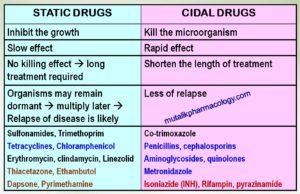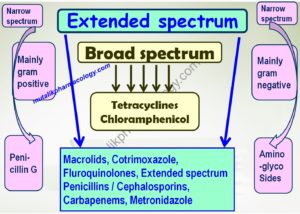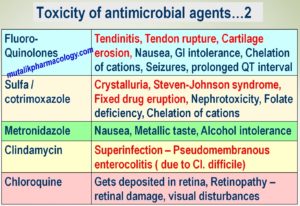Introduction to Chemotherapy
Here are some videos. They discuss the basic concepts of antimicrobial agents. Go through the videos. They will be helpful.
Chemo means chemicals and therapy is the treatment of diseases.
Initially, if any disease is treated with the help of drugs (means without surgical intervention or invasive procedures), then this method of treatment was called as chemotherapy.
Later the word Chemotherapy stabilized on the meaning that chemotherapy would mean treatment of infections and infestations.
Still later, in reference to cancer, with the availability of three methods to treat it such as drugs, surgery, and radiation; the word chemotherapy came in use with the meaning that it is the drug treatment of cancers, and hence called as cancer chemotherapy.
The section of chemotherapy on this website encompasses all these meanings; and the section of chemotherapy discusses various antimicrobial agents used for bacterial, viral, and fungal infections; as well as cancer chemotherapy.
Introduction to Chemotherapy shall focus only on antimicrobial agents, their basic actions and mechanisms, and review of their important aspects.
To me, between World War I (1914 – 1918) and and World War II (1939 – 1945), there is one notable difference.
If a soldier was wounded during World War I, the fate of his wound was infection, gangrene, and amputation of that limb; or septicemia (bacterial multiplication in blood and the spread of infection) and death. Because there was no antimicrobial agent to fight the infection.
On 12th February 1941, Albert Alexander was the first individual on this planet to receive intravenous infusion of peniciilin – the first antibiotic of this world. And this changed the fate of thousands of soldiers from World War II.
Now an antibiotic was available if you would get an infection.
Thus World War II was notably different than World War I.
The world now is different. The difference was initiated by Sir Alexander Fleming, Ernst B Chain, and Sir Howard Florey who invented penicillin – the first antibiotic of the world; and Gerhard Domagk who invented Prontosil – a sulfa drug, the first antimicrobial agent of the world.
SAQ/Viva
What is an antimicrobial agent and what is an antibiotic?
Antimicrobial agent means a drug that inhibits microorganisms.
If this is antimicrobial agent itself is obtained/prepared from some microorganism, then such a drug is called Antibiotic.
Otherwise – it is just an antimicrobial agent.
Examples:
Antibiotics (Antimicrobials prepared from microorganisms): Penicillin G (from the fungi Penicillium notatus, Penicillium crysogenium), Cephalosporins, streptomycin, Erythromycin, Tetracycline, Vancomycin. (Many of them are obtained from fungi)
Antimicrobials prepared from synthetic / chemical source: Sulfa drugs, co-trimoxazole, metronidazole, fluoroquinolones (ofloxacin, norfloxacin etc)
Some terminology
STATIC or CIDAL
Static: Reduces growth
Cidal: Kills the microorganism
S0, the words depending on the action of a drug such as –
Bateristatic / Bactericidal / Fungistatic / Fungicidal
SAQ/Viva
Give examples of Static / Cidal drugs. Enumerate differences between static and cidal drugs.

SAQ/Viva
What do you mean by spectrum of activity of antimicrobial agents? Mention drugs with narrow spectrum of activity and broad spectrum of activity.
The word SPECTRUM is an English term meaning RANGE.
For example – if we make a list of microorganisms that are inhibited by an antimicrobial agent, then the whole list together is called the spectrum of activity of this drug. Depending upon which bacteria are inhibited, one may call it antibacterial spectrum of a drug.
If this list is quite short – the drug is said to have narrow spectrum of activity. (Such drugs inhibit a limited number and variety of organisms).
If the number of microorganisms inhibited by a drug is quite large, and of different variety, then we say that this drug has a broad spectrum of activity.
(A) Drugs with narrow spectrum of activity:
- Penicillin G (Benzyl penicillin): Mostly inhibits a limited number of gram positive organisms
- Aminoglycosides (Streptomycin, Gentamicin, Amikacin): Mostly inhibit a limited number of gram negative organisms
(B) Drugs with Extended spectrum of activity:
These drugs have quite an extended spectrum of activity as compared to the narrow spectrum antimicrobials.
Examples:
- Semisynthetic penicillins such as amoxicillin: (Inhibits mainly gram positive and many gram negative organisms)
- Generation II cephalosporins (Cefuroxime, Cefoxitin) and Generation III cephalosporins (Cefotaxime, Cefopodoxime, Ceftriaxone) (They inhibit gram positive as well as many gram negative organisms)
- Macrolids (Erythromycin, Clarithromycin, Axithromycin etc) (They inhibit gram positive, gram negative, and many other atypical organisms)
- Co-trimoxazole (A combination of sulfa drug and trimethoprim) Inhibits many gram positive as well as gram negative organisms.
(C) BROAD SPECTRUM ANTIMICROBIALS: Tetracyclines, Chloramphenicol
Classically, only two groups of drugs are called BROAD SPECTRUM ANTIBIOTICS, and they are TETRACYCLINES and CHLORAMPHENICOL.
They inhibit a wide variety of organisms including gram positive and gram negative bacterial, and also atypical organisms such as mycoplasma, ricketsiae, chlamydia, malarial parasite, treponems, ameba etc.
Sometimes, the word “narrow” and “broad” may be used as relative terms to compare between the groups. For example: Read the following statements and understand the meaning:
-Amoxicillin is a broad spectrum penicillin as compared to Penicillin G.
-Fluoroquinolines have a broad spectrum of activity.
-Newer antimicrobials in a particular group are likely to be broad spectrum.
-1st generation are narrow spectrum drugs.
The above material may be asked in the form of a question ! Such as –
SAQ/Viva
Classify antimicrobial agents based on spectrum of activity.
Text is already described above. It can be presented as below:

SAQ/Viva/LAQ
Classify Antimicrobial agents based on their mechanism of action.
Let us understand that the microorganisms do have a certain structure that includes cell wall, nucleus, and other components. The organism exists due to all of them.
Antimicrobial agents intervene in the process of growth and multiplication of the microorganisms.
- Some drugs inhibit the synthesis of cell wall – drugs such as penicillins, cephalosporins, and vancomycin.
- Some others interfere with the process of protein synthesis by interfering with a particular process: Tetracyclines, Aminoglycosides; Chloramphenicol, Macrolids
- Some may be inhibiting a specific enzyme to affect a step in the synthesis of DNA/RNA: Rifampin, Quinolones
- Some antimicrobials may interfere with the formation of specific metabolites needed for DNA synthesis in the microorganisms: Co-trimoxazole, Pyrimethamine, Dapsone
Based on the above description, below is presented the classification of antimicrobials based on their mechanism of action. (Downward arrow means inhibition or decrease)

Toxicity of antimicrobial agents
Penicillins and cephalosporins are in general considered to be safer antimicrobial agents – means the drugs with good therapeutic index.
Some of the most toxic antimicrobial agents (Antimicrobials with narrow therapeutic index) are:
- Broad spectrum antibiotics: Tetracyclines and Chloramphenicol
- Aminoglycosides (Streptomycin, Gentamicin etc)
- Vancomycin
- An antifungal agent – Amphotericin B
1. Tetracyclines have antianabolic effects. They chelate the calcium in bones and teeth, and lead to damage of teeth and bones. They produce hepatotoxicity, nephrotoxicity, and some of them produce photosensitivity reactions.
2. Chloramphenicol can produce agranulocytosis due to severe bone marrow suppression. This bone marrow suppression by chloramphenicol is an idiosyncratic reaction. Failure to conjugate chloramphenicol in younger children can lead to Gray Baby Syndrome.
-3. Aminoglycosides such as streptomycin, gentamicin, amikacin etc. produce common toxic effects – (a) Ototoxicity – Vestibulocochlear Nerve toxicity (VIII Nerve toxicity), (b) Nephrotoxicity (Usually tubular necrosis), and (c) Neuromuscular blockade – Skeletal muscle weakness.
4. Vancomycin produces VIII Nerve toxicity (Vestibulocochlear toxicity – Ototocicity), Nephrotoxcity, Flushing of the upper part of the body (Red neck syndrome/Red man syndrome), and hypotension.
5. Amphotericin B (an antifungal agent) produces infusion related toxicity in the form of nausea, chills, fever, breathlessness, and hypotension. It also produces nephrotoxicity, bone marrow suppression, and seizures.

The next table describes the toxicity of some more antimicrobial agents.

SAQ/Viva
Define Superinfection. Mention its manifestations. Mention the prevention and treatment of Superinfection.
Superinfection or Supra-infection – means – appearance of a new infection during the treatment of an infection with an antimicrobial agent.
An antimicrobial agent while inhibiting the infecting organisms, may also suppress and inhibit the commensal organisms in particular tissues. Commensals comprise of the normal bacterial flora of various tissues. When this normal bacterial flora is inhibited, other pathogenic organisms may get an opportunity to grow and multiply; and then these may produce another infecction – this infection is called Superinfection.
Superinfection prevails due to irrational or excess use of broad or extended spectrum antimicrobial agents. The mucous membranes of Gastrointestinal tract, oral cavity, respiratory tract, and the skin are most common to get affected due to superinfection. Superinfection shall obviously be more likely in immune compromised hosts and in patients with diabetes mellitus,
The organism and the